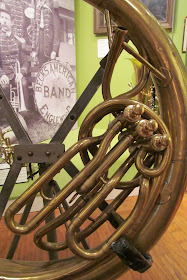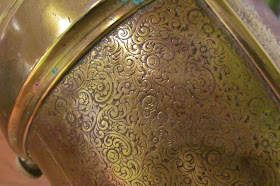All of the evidence points to the Sousaphone made by J. W. Pepper, serial number 8800, and shown
a few posts below, as the very first one. Sousa gave Pepper the idea for the horn back in 1892, but what year was it actually built?
Having examined the horn close up, it seems that the answer is provided right there on the bell - 1893:
However, many Pepper instruments have this, or something like this, on their bells (see this
website for a detailed list). For example, here is a tuba, serial number 9293:
And here's a trombone, serial number 11054 - although now it clarifies that it is referring to receiving some sort of award at the "World's Fair Columbian Exposition Chicago 1893":
Same goes for this cornet, serial number 11158 - quite a ways from 8800, meaning it may very well have been built later than 1893:
It would seem that this information on the bell of these instruments is not providing the date of construction, but only boasting of the award received at the World's Fair in 1893.
+World's+Fair+in+Chicago,+opening+of+NY+building+(in+Bierley,+p.+18).jpg) |
| Photo courtesy of Paul Bierley, The Incredible Band of John Philip Sousa, p. 18 |
Sousa's Band performed at the Fair, both at the dedication of the buildings in October 1892 (shown above), and for parts of May and June 1893, but did they feature the first Sousaphone in the band that latter year? We simply don't know -
yet.
What we
do know is that in 1893, Pepper received a World's Fair award for band instruments (noted in the September 30, 1893 edition of
The Music Trade Review - vol.18, no. 10, p. 1). And this fact was stamped on the bells of many of their instruments from that point on.
So was the first Sousaphone built in 1893? Possibly, but we'll have to look elsewhere to find a certain answer.




.jpg)
.jpg)
.jpg)




+World's+Fair+in+Chicago,+opening+of+NY+building+(in+Bierley,+p.+18).jpg)
.JPG)








